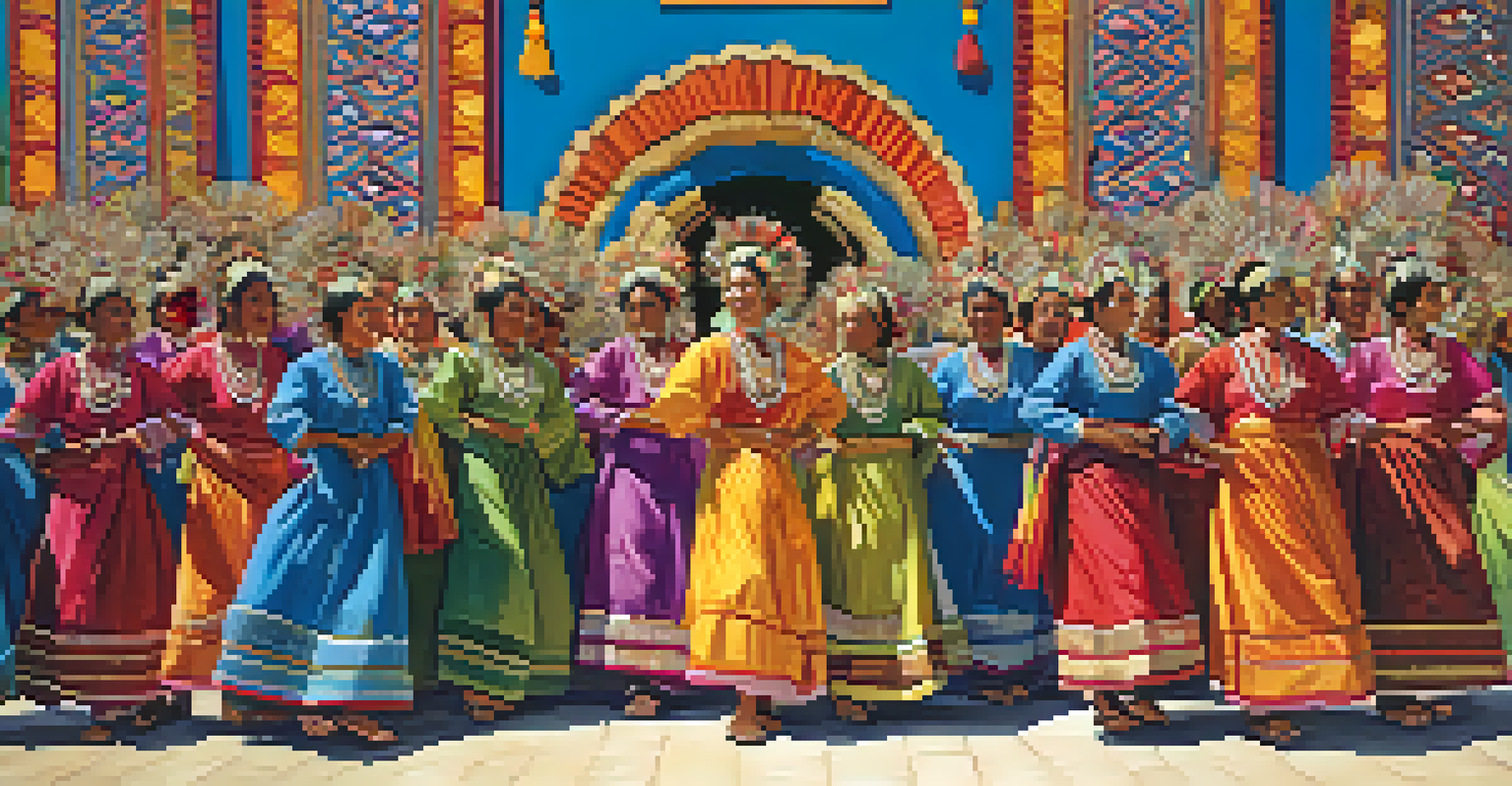The Qoyllur Rit'i Pilgrimage: A Spiritual Trek in Peru

What is the Qoyllur Rit'i Pilgrimage?
The Qoyllur Rit'i pilgrimage is an annual event held in the Andes of Peru, attracting thousands of devotees. It takes place during the full moon in late May or early June and is a vibrant mix of spirituality and tradition. This pilgrimage honors the Lord of Qoyllur Rit'i, a figure believed to possess miraculous powers, drawing many pilgrims seeking blessings and guidance.
The journey of a thousand miles begins with a single step.
Spanning over several days, the pilgrimage involves a physically demanding trek to the Sinakara Valley, located near the Ausangate mountain. Participants often carry heavy loads, including food, religious icons, and offerings, symbolizing their devotion and commitment. This arduous journey sets the stage for a deeply personal spiritual experience, encouraging reflection and connection.
The event is steeped in rich cultural significance, blending indigenous Andean beliefs with Catholicism. As pilgrims walk in devotion, they often participate in traditional dances and rituals, showcasing the vibrant cultural tapestry of the region. This fusion of faith and culture is what makes the Qoyllur Rit'i pilgrimage unique and deeply meaningful.
The Spiritual Significance of Qoyllur Rit'i
At its core, the Qoyllur Rit'i pilgrimage is a profound spiritual journey. For many, it serves as a time for introspection, healing, and renewal. Pilgrims often seek a deeper understanding of their faith and a connection to the divine, using the trek as a form of penance or gratitude.

The journey is not just physical; it's a rite of passage for many participants. As they navigate the challenging terrain, they encounter both physical and spiritual obstacles, fostering resilience and determination. This transformative experience allows pilgrims to emerge with a renewed sense of purpose and faith.
Spiritual Journey of Pilgrimage
The Qoyllur Rit'i pilgrimage is a profound spiritual journey that blends physical endurance with deep introspection and communal faith.
Moreover, the pilgrimage is a communal event, bringing together individuals from diverse backgrounds. This shared experience fosters a sense of belonging and unity among participants, transcending cultural and social barriers. It highlights the power of collective faith and the importance of community in spiritual practices.
The Route: A Test of Endurance and Faith
The trek to the Sinakara Valley is no easy feat, often described as a test of endurance for those who embark on it. Pilgrims typically start their journey from the town of Mahuayani, making their way through rugged terrain that can be both breathtaking and challenging. The high altitude adds an extra layer of difficulty, pushing each participant to their physical limits.
In every walk with nature one receives far more than he seeks.
Along the route, pilgrims often share stories and songs, creating a sense of camaraderie among strangers. This shared spirit of resilience transforms the arduous walk into a celebration of faith and culture. It’s not uncommon to see groups supporting one another, lending hands or sharing supplies as they navigate the demanding landscape together.
As they ascend towards the glacier and the sanctuary, the beauty of the Andes serves as a constant reminder of the divine presence. The stunning vistas inspire awe and reverence, reinforcing the spiritual purpose of the pilgrimage. For many, the journey itself becomes a sacred act—each step a prayer, each breath an affirmation of their faith.
Traditions and Rituals During the Pilgrimage
The Qoyllur Rit'i pilgrimage is rich in traditions and rituals that highlight the deep-rooted cultural heritage of the participants. One of the most notable practices is the ‘Qoyllur Rit'i dance,’ which takes place in front of the sanctuary. Dancers adorned in colorful traditional attire perform to honor the Lord, embodying the spirit of joy and devotion.
Pilgrims also engage in rituals such as the offering of coca leaves, a sacred plant in Andean culture. These offerings serve as a way to communicate with the spirits and seek protection and guidance. The act of giving is seen as a vital part of the pilgrimage, fostering a connection between the physical and spiritual worlds.
Cultural Fusion in Traditions
The event showcases a unique blend of indigenous Andean beliefs and Catholicism, highlighting rich cultural traditions through rituals and dances.
Additionally, the pilgrimage features a unique blend of Catholic and indigenous traditions, showcasing the syncretism of beliefs. Mass is held in the open air, and prayers are offered to both the Lord of Qoyllur Rit'i and the Virgin Mary. This harmonious coexistence of faiths reflects the rich cultural tapestry of the region and the adaptability of spirituality.
Challenges Faced by Pilgrims
While the Qoyllur Rit'i pilgrimage is a celebration of faith, it also presents its fair share of challenges. The high altitude can lead to altitude sickness, which affects many participants, especially those who are not accustomed to the conditions. It’s essential for pilgrims to acclimatize properly before undertaking the trek to ensure their safety.
The physical demands of the journey can also take a toll on the body. Many pilgrims experience fatigue, sore muscles, and blisters as they navigate the rugged paths. However, these challenges are often embraced as part of the spiritual journey, with many finding strength in their faith and the support of fellow pilgrims.
Additionally, the unpredictable weather in the Andes can pose risks, with sudden changes in temperature and storms potentially affecting the pilgrimage. Despite these hurdles, the determination and resilience of the participants shine through, demonstrating the power of faith to overcome obstacles.
The Role of Community in the Pilgrimage
Community plays a vital role in the Qoyllur Rit'i pilgrimage, as many pilgrims travel in groups, often representing their local villages or families. This sense of belonging fosters a spirit of solidarity and support throughout the journey. Together, they share meals, stories, and encouragement, creating lifelong bonds that enrich the experience.
The communal aspect extends to the preparation for the pilgrimage as well. Families often come together to make offerings, prepare traditional foods, and create colorful garments for the event. This collective effort not only strengthens familial ties but also deepens the communal connection to their cultural heritage and spiritual beliefs.
Community Support is Vital
The pilgrimage fosters a strong sense of community, as participants travel in groups, sharing experiences and reinforcing cultural ties.
Moreover, the pilgrimage serves as a platform for cultural exchange, as pilgrims from various backgrounds come together to celebrate their faith. This diversity enriches the experience, allowing participants to learn from one another and appreciate the shared values that transcend individual differences. It highlights the importance of community in fostering spiritual growth and solidarity.
The Impact of Qoyllur Rit'i on Local Culture
The Qoyllur Rit'i pilgrimage has a profound impact on the local culture, serving as a vibrant expression of Andean traditions. Its celebration attracts not only pilgrims but also tourists and scholars interested in the rich cultural heritage of the region. This influx of visitors helps to preserve and promote local customs, ensuring they remain a vital part of the community's identity.
Additionally, the pilgrimage supports local economies, as vendors set up stalls to sell traditional foods, crafts, and offerings. This economic boost is essential for many families, creating opportunities for local artisans and entrepreneurs. The event thus becomes a catalyst for both cultural preservation and economic growth.

Furthermore, the pilgrimage's emphasis on communal values reinforces the importance of cultural identity among younger generations. As families pass down traditions and stories related to the pilgrimage, they instill a sense of pride and belonging in their children. This continuity of culture ensures that the essence of the Qoyllur Rit'i pilgrimage will endure for years to come.